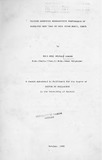| dc.description.abstract | A study of breed and environmental factors, both
internal and external, affecting calving interval of range-fed
beef cattle was conducted at Athi River ranch in Kenya.
Breeding females comprised the Boran, the small East African
Shorthorn Zebu (EASZ) and their Fl progeny from Hereford bulls.
Fertility was highly seasonal (P ~ 0.005) and the
shortest mean calving intervals were recorded from animals
that conceived between November and January followed by the
period from May to July. When mating was confined between May
and July, fertility became significantly influenced (P < 0.005)
by the calving month preceeding conception, with heifers being
the most affected. Under such conditions animals that calved
down during March-April had a higher fertility during the
subsequent breeding period. Increased rainfall during the
month prior to conception was associated with a highly
significant (P < 0.01) linear improvement in fertility
depending on conception period.
significant (P.£. 0.005).
The target joining weight was around 318 kg.
Year effects were highly
Above the
target weight, up to about 410 kg, fertility became a function
of the absolute bodY weight such that heavier cows at joining
were more fertile (P ~ 0.01) than lighter ones. There was
evidence to suggest that the depressing effect of suckling
could dominate influence of body weight unless joining weight
was well above 318 kg. Below the target weight, relatively
higher fertility was associated with females that gained
weight or suffered less body weight loss during the month
prior to conception. Previously dry cows tended to gain
weight prior to conception to the "detriment of fertility
(P<O.OOS). Monitoring of proportionate body weight changes
during the month prior to conception was a better method of
assessing fertility than weight changes
conception.
Influence of dry season supplementation was significant
far-removed from
but was modified by a number of factors such as age, year and
previous parity. There was no significant difference in
fertility of cows that were supplemented before calving with
energy or energy plus urea. Generally, cows that were
supplemented after calving had a higher fertility.
Fertility improved as the dam's age increased from
three years onwards but declined after about nine to ten
years. Young females were more vulnerable to adverse
post-partum nutritional conditions but they benefitted by
calving down one month earlier than the older cows.
Effects of weaning period, weaning month,previous
parity and weaning year were marginally significant (P<O.OS).
The mean calving interval of the EASZ was shorter
(P~O.OS) than that of the Borans by only 17 days. However,
there was evidence that when mating occurred between November
and January or when supplementation was provided, the Boran
and Boran crosses had a higher fertility compared to the small
zebus and their crosses. | en |

